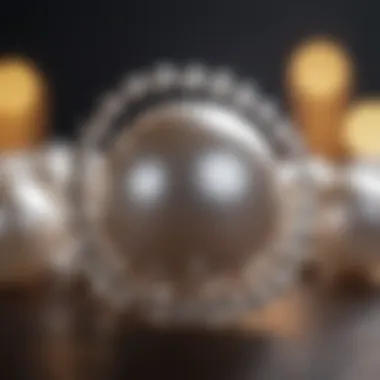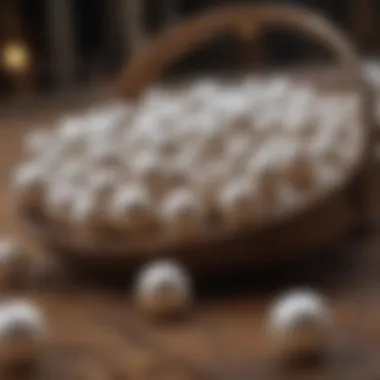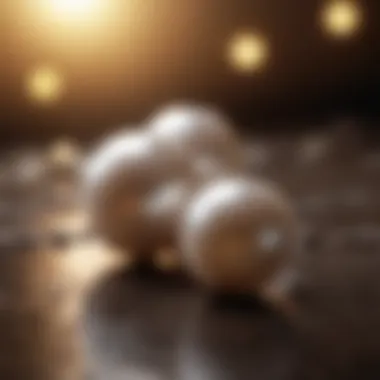Exploring the Factors Behind Natural Pearl Prices


Intro
The market for natural pearls has seen a fascinating evolution over the centuries. Understanding the factors that influence the pricing of these exquisite gems requires a keen eye for detail and a deep appreciation for their unique qualities. The intricacies involved in determining natural pearl prices can seem daunting at first, but they unfold into an engaging narrative rich with historical significance, rarity, quality, and prevailing market trends. This article aims to illuminate these facets, serving as a vital resource for enthusiasts and investors alike.
Understanding Natural Pearl Pricing
The journey of natural pearls starts in the ocean. These gems are not created on demand; they develop through a complex process that involves life in marine environments. This inherent rarity lays the foundation for their pricing. As we dive deeper into this exploration, we will dissect how various elements, from historical context to the intrinsic qualities of the pearls, contribute to their value in today’s market.
The Origins of Natural Pearls
The origins of natural pearls provide a crucial foundation in understanding their pricing and value. Recognizing how pearls form in nature and distinguishing between natural and cultured varieties is essential for collectors and investors alike. This knowledge not only enhances appreciation for these gems but also clarifies the factors influencing their market prices.
Formation of Pearls
Natural pearls form through a fascinating biological process. Pearls develop inside the soft tissue of certain mollusks, primarily oysters and mussels, as a defense mechanism. When an irritant, such as a grain of sand, enters the mollusk's body, it secretes layers of nacre, a substance composed of aragonite and conchiolin. Over time, these layers build up around the irritant, culminating in the creation of a pearl.
The natural formation of pearls can take several years. Factors such as the species of the mollusk, water temperature, and environmental conditions heavily influence this process. As a result, the rarity of natural pearls significantly impacts their pricing, as authentic natural pearls are much harder to find compared to cultured varieties.
In addition, natural pearls come in various shapes and sizes. Each pearl is unique, and factors such as luster, surface quality, and color variations add to their individuality, further affecting their market value.
Natural vs.
Cultured Pearls
Understanding the difference between natural and cultured pearls is essential for buyers. Natural pearls occur spontaneously in nature, while cultured pearls are formed through human intervention. Cultured pearls are created by intentionally introducing an irritant into the mollusk, prompting it to produce nacre around this object.
Although both types of pearls may appear similar, cultural practices have led to a much higher availability of cultured pearls. This availability tends to drive down their prices compared to natural pearls, which are regarded as rare treasures.
Here are some key distinctions:
- Formation: Natural pearls grow without human intervention; cultured pearls are induced by human action.
- Rarity: Natural pearls are exceedingly rare, making them more valuable. Cultured pearls, while beautiful, are more accessible.
- Pricing: Typically, natural pearls command higher prices due to their rarity, unique shapes, and characteristics.
Understanding these origins enhances buyers' appreciation and informs their purchasing decisions. Awareness of the formation process and the difference between natural and cultured pearls enriches the conversation about value, ultimately influencing market behavior.
Factors Influencing Natural Pearl Prices
Understanding the factors that influence natural pearl prices is essential for buyers and collectors alike. The natural pearl market is complex and affected by a variety of elements that determine both the supply and demand side of pearls. Key factors include rarity and availability, various quality indicators, color variations, historical significance, and evolving market trends. Each of these elements plays a role in establishing the value of natural pearls and affects purchasing decisions in significant ways.
Rarity and Availability
Rarity is one of the most crucial factors influencing the price of natural pearls. Natural pearls are formed spontaneously within mollusks, typically resulting in significantly fewer occurrences compared to cultured pearls. The limited supply increases their value. Global climate changes and pollution threaten habitats, leading to challenges in the availability of natural pearls. As more collectors seek them, their prices continue to escalate due to this scarcity.
Quality Indicators


Luster
Luster is a vital aspect of pearl quality, referring to the way light reflects off the surface of the pearl. High-luster pearls exhibit a bright, mirror-like sheen, which enhances their visual appeal and desirability. Pearls with excellent luster are often considered more valuable. The uniqueness of luster contributes to its importance, as it defines the overall quality. However, achieving lustrous pearls is not easy; it requires ideal environmental conditions and proper nacre thickness.
Surface Quality
Surface quality examines the external appearance of a pearl. Pearls with fewer blemishes or marks command higher prices. This characteristic is significant for both aesthetic pleasure and durability in jewelry. The uniqueness of smooth surface pearls appeals to luxury buyers. Conversely, a rough or pitted surface can detract from value. Thus, surface quality is essential for collectors focusing on investment potential.
Shape and Size
Shape and size are crucial indicators of quality in pearls. Round pearls are generally the most sought after, as they are rare and considered the standard for perfection. Larger pearls, typically over 10 mm, are also more valuable due to their scarcity. A unique feature of size is that it can also denote age, with older pearls often being more valuable. Buyers often prefer pearls that fit specific shapes and sizes for their collections or designs.
Color Variations
Natural pearls come in a vast array of colors, including white, pink, gold, and black. Color variations can significantly affect prices. Some colors may hold special significance or popularity, leading to higher demand. Additionally, over time, certain colors may trend, affecting their value. Awareness of color can guide buyers in selecting pearls that fit current market preferences while ensuring investment growth.
Historical Significance
Historical significance plays a role in the appraisal of natural pearls. Pearls that have a storied past or connection to famous individuals can draw higher prices. These pearls often carry an emotional resonance and cultural value, enriching their worth beyond mere aesthetics. Knowledge of the history helps collectors justify premium prices as these pearls represent moments in time. This historical narrative adds an engaging element to pearl buying.
Market Trends
Market trends are constantly shifting due to changing consumer preferences, making it essential for buyers to stay informed. Economic factors, global events, and fashion influences can all affect how natural pearls are perceived, leading to price fluctuations. Awareness of current trends can inform purchasing decisions, ensuring that investors select pearls that may appreciate over time. Engaging with industry analyses can provide insights into future market movements in natural pearls.
Understanding the interplay of these factors can lead to a more informed purchasing decision and greater appreciation of natural pearls.
Evaluating Pearl Quality
Evaluating the quality of natural pearls is crucial for understanding their market value. Quality determines not only the beauty of pearls but also their desirability among collectors and investors. Several aspects play a role in this evaluation, making it a nuanced process that requires careful consideration.
Grading Systems
Grading systems are essential for assessing pearl quality. Various organizations and pearl experts have developed guidelines that help categorize pearls based on specific criteria. The most commonly used grading factors include luster, surface quality, shape, size, and color. Each of these factors can significantly influence the pearl's overall value.
For instance, the luster of a pearl indicates how much light reflects off its surface. Pearls with high luster appear bright and radiant, while those with lower luster may appear dull and less appealing. Surface quality refers to any blemishes or imperfections on the pearl's exterior. A pearl with fewer surface imperfections is generally valued higher.
Shape also affects pricing, with round pearls often fetching a premium compared to oddly shaped ones. Size plays a role as well; larger pearls tend to be more valuable, but this can vary based on other qualities. Color, too, influences value, as some hues are rarer and can command higher prices. In summary, understanding grading systems is vital for evaluating the quality of natural pearls.
Role of Gemologists
Gemologists are trained professionals who play a significant role in evaluating pearl quality. Their expertise is critical in determining the authenticity and overall quality of pearls. These experts utilize various techniques and tools to assess the characteristics of pearls accurately.
Gemologists not only apply grading systems but also provide insights into the market trends and factors that may influence pearl prices. They can identify natural pearls versus cultured ones, further affecting the valuation. Their professional analysis often guides buyers in making informed decisions when investing in pearls.
In addition, a gemologist can offer certification for pearls, which adds an extra layer of trust for buyers. This certification, when available, often establishes resale value and upholds the pearl's provenance.


The evaluation of natural pearls is a complex process. It requires knowledge of grading systems and an understanding of market values. Gemologists play an essential role in this process, providing clarity and reliability.
By comprehensively evaluating pearl quality, buyers and investors can better navigate the sometimes murky waters of the natural pearl market. With insights from gemologists and established grading systems, they can make informed choices that align with their collecting or investment goals.
Buying Natural Pearls
Understanding the intricacies of buying natural pearls is essential for anyone interested in this precious gem. The natural pearl market is unique, characterized by factors that set it apart from other adornments or investments. As pearls are not only beautiful but also carry a rich history, purchasing involves various considerations. The right choices can lead to both aesthetic satisfaction and potential investment value.
Reputable Sources
When purchasing natural pearls, the significance of selecting reputable sources cannot be overstated. Authenticity is paramount, as the market is filled with imitations. Trusted jewelers enhance buyer confidence. They offer guarantees on their pearls and often provide documentation regarding the provenance of the pearls. Buying from established sources can shield against counterfeit products.
Consider the following when choosing a source:
- Established Retailers: Look for retailers with a long-standing reputation in the industry.
- Certification: Ensure that the pearls come with proper certification indicating they are natural.
- Customer Reviews: Research customer feedback to navigate your options better.
Online vs.
Offline Purchases
The debate between online and offline purchasing has become more relevant in today's digital age. Each method presents distinct advantages and challenges. Online marketplaces may offer convenience and a broader selection, while physical stores provide the chance to examine the pearls directly.
Online Benefits:
- Greater variety of options and potential for lower prices.
- Research capabilities through reviews and seller ratings.
Offline Benefits:
- Ability to see and feel the product before purchasing.
- Expert advice from jewelers, leading to more informed decisions.
Ultimately, the choice depends on personal comfort level and buying goals.
Assessing Authenticity
Assessing the authenticity of natural pearls is a crucial step in the buying process. Here are practical tips for buyers:
- Visual Inspection: Check for imperfections, which are often present in natural pearls. Cultured pearls may have a more uniform appearance.
- Nacre Thickness: Genuine pearls generally have thicker nacre, affecting luster and quality.
- Consult Experts: Engage gemologists for their insights on authenticity.
Authenticity verification is not just a precaution; it safeguards your investment.
By understanding these aspects of buying natural pearls, you ensure a more informed purchasing experience.
Investment Potential of Natural Pearls
Natural pearls hold a unique position in the gemstone market. Their formation occurs naturally, which adds to their allure. This rarity plays a significant role in their investment potential. As more people draw interest towards sustainable and distinctive options, natural pearls become a more attractive alternative.


Market Demand Dynamics
The market for natural pearls is influenced by several factors. Firstly, consumer preferences tilt towards unique and rare items as opposed to mass-produced ones. This shift has enhanced the demand for natural pearls, making them sought-after collectibles and investment options. Economic stability also influences market demand. During times of economic growth, wealthy individuals often seek to invest in luxurious items, including pearls. Conversely, in economic downturns, luxury goods typically see a decrease in demand.
Additionally, trends in fashion can significantly impact natural pearl prices. High-profile celebrities and influencers who wear natural pearls can spark renewed interest in them. This fashion influence leads collectors to invest in newer designs and varieties, further shaping the market dynamics.
Long-Term Value Preservation
Investing in natural pearls is often perceived as stable due to their historical significance and intrinsic value. Natural pearls have survived trends, maintaining their stature over centuries. Their value does not depreciate easily, and they can appreciate over time, especially when sourced from reputable dealers.
Considerations when investing include understanding the pearl's quality, size, and rarity. Higher quality pearls tend to see more significant appreciation in value. The right purchase can yield substantial returns. It is also important to maintain the pearls properly to ensure they stand the test of time.
In summary, natural pearls present a compelling option for investment. The dynamic market demand and the ability for long-term value preservation create an opportunity for enthusiasts and investors alike. As the market evolves, staying informed about trends and shifts will be crucial for making sound investments.
Challenges in the Natural Pearl Market
The natural pearl market faces several significant challenges that affect its sustainability and pricing. Understanding these challenges is essential for anyone involved in the pearl industry, including buyers and investors. Issues such as environmental changes and the rise of synthetic alternatives directly impact the availability, quality, and pricing of natural pearls. Analyzing these factors provides valuable insight into the future trajectory of the natural pearl market.
Environmental Factors
Natural pearls are formed within certain species of mollusks, and their health is contingent on environmental conditions. Water quality, temperature, and habitat changes can cause significant declines in pearl-producing populations. Pollution from human activities leads to the destruction of oyster beds and other critical ecosystems.
Moreover, climate change poses a pressing challenge. Altered water temperatures can affect the reproductive cycles of mollusks, ultimately reducing pearl production rates. Such trends threaten the supply side of the natural pearl market, leading to increased prices due to scarcity. Buyers must remain alert to ecological changes that can affect pearl availability, impacting their purchasing decisions over time.
Synthetic Pearl Alternatives
The introduction of synthetic pearls has changed market dynamics significantly. These pearls, made from materials such as glass and plastics, are more plentiful and affordable than natural pearls. While they may offer aesthetic appeal, their presence raises questions about authenticity and value in the market.
Even though synthetic pearls can mimic some qualities of natural ones, they lack the uniqueness that comes with being a natural product. Collectors and investors generally prefer natural pearls for their rarity and historical significance. However, as synthetic options evolve in quality, they could appeal to a broader audience, potentially saturating the market and driving down prices for natural pearls.
The ongoing competition between natural and synthetic pearls necessitates constant monitoring by industry stakeholders. Natural pearl enthusiasts must understand these dynamics to make informed purchasing choices and investments.
In summary, the challenges in the natural pearl market revolve around environmental factors and the ongoing rise of synthetic alternatives. Staying informed about these issues is essential for those who appreciate the value of natural pearls, ensuring that they can navigate the complexities of buying and investing in these unique treasures.
The Future of Natural Pearls
Understanding the future of natural pearls is crucial in a context where the market is evolving rapidly. Farmers strive to balance supply and environmental needs while collectors seek quality and authenticity. As consumers become more aware of sustainable practices, the pearl industry must adapt. Emerging trends and environmental considerations are shaping a new era for natural pearls.
Emerging Trends
Several trends are currently impacting the natural pearl market. One significant trend is the increasing interest in ethical sourcing. Customers are becoming more inclined to purchase products that have been sourced responsibly. This change is stimulating pearl farmers to adopt better harvesting techniques that do not harm the ecosystem.
Another trend involves technology's influence on pearl certification. Advanced imaging techniques help in assessing pearl quality more accurately than before. This precision is allowing for better pricing structures as consumers have more trust in the evaluation process. The use of blockchain technology for tracking the authenticity of pearls is also on the rise. Such innovations lead to enhanced transparency, which greatly benefits buyers.
There is also a growing interest in unique, natural pearl colors. Pearls with rare shades command higher prices. The market now values creativity in design, leading to new jewelry collections that feature unconventional and vibrant pearls. Awareness of the historical significance intertwined with pearls adds another layer to their desirability.
Conservation and Sustainability
Conservation is becoming a central issue in the future of natural pearls. Overharvesting has put pressure on certain species of mollusks that produce natural pearls. Sustainable practices are now critical to ensuring the long-term viability of the industry. Initiatives aimed at conserving marine ecosystems can benefit both biodiversity and pearl production.
Industry stakeholders are encouraged to engage in practices that support habitat restoration. Participating in conservation efforts can foster goodwill among consumers and enhance the brand image. Moreover, certification bodies are establishing guidelines on sustainability. Companies aligning with these standards often see a positive response from environmentally-conscious buyers.







